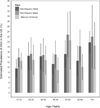Prevalence and sociodemographic correlates of antinuclear antibodies in the United States
- PMID: 22237992
- PMCID: PMC3330150
- DOI: 10.1002/art.34380
Prevalence and sociodemographic correlates of antinuclear antibodies in the United States
Abstract
Objective: To estimate the prevalence, types, and sociodemographic and biobehavioral correlates of antinuclear antibodies (ANAs) in the US.
Methods: We conducted a cross-sectional analysis of 4,754 individuals from the National Health and Nutrition Examination Survey 1999-2004. ANAs were assessed by indirect immunofluorescence. In ANA-positive individuals, cellular staining patterns were determined, and specific autoantibody reactivities were assessed by immunoprecipitation.
Results: The ANA prevalence in the US population of individuals ages 12 years and older was 13.8% (95% confidence interval [95% CI] 12.2-15.5%). ANA prevalence increased with age (P=0.01), and ANAs were more prevalent among females than males (17.8% versus 9.6%; P<0.001), with the female-to-male ratio peaking at 40-49 years of age. ANA prevalence was modestly higher in African Americans compared with whites (age-adjusted prevalence odds ratio [POR] 1.30, 95% CI 1.00-1.70). Remarkably, ANAs were less common in overweight and obese individuals (age-adjusted POR 0.74) than in persons of normal weight. No significant associations of ANA with education, family income, alcohol use, smoking history, serum levels of cotinine, or C-reactive protein were observed. In ANA-positive individuals, nuclear patterns were seen in 84.6%, cytoplasmic patterns were seen in 21.8%, and nucleolar patterns were seen in 6.1%; the most common specific autoantibodies were anti-Ro (3.9%) and anti-Su (2.4%).
Conclusion: These findings suggest that more than 32 million persons in the US have ANAs, and that the prevalence is higher among females, older individuals, African Americans, and those with a normal body weight. These data will serve as a useful baseline for future investigations of predictors and changes in ANA prevalence over time.
Copyright © 2012 by the American College of Rheumatology.
Figures



Similar articles
-
Increasing Prevalence of Antinuclear Antibodies in the United States.Arthritis Rheumatol. 2020 Jun;72(6):1026-1035. doi: 10.1002/art.41214. Epub 2020 Apr 30. Arthritis Rheumatol. 2020. PMID: 32266792 Free PMC article.
-
Sunscreen use associated with elevated prevalence of anti-nuclear antibodies in U.S. adults.J Autoimmun. 2024 Dec;149:103340. doi: 10.1016/j.jaut.2024.103340. Epub 2024 Nov 24. J Autoimmun. 2024. PMID: 39581147
-
Increasing Prevalence of Antinuclear Antibodies in the United States.Arthritis Rheumatol. 2022 Dec;74(12):2032-2041. doi: 10.1002/art.42330. Epub 2022 Oct 19. Arthritis Rheumatol. 2022. PMID: 36054084 Free PMC article.
-
[Antinuclear antibodies in patients with chronic fatigue syndrome].Nihon Rinsho. 2007 Jun;65(6):1067-70. Nihon Rinsho. 2007. PMID: 17561698 Review. Japanese.
-
Antinuclear Antibodies: Marker of Diagnosis and Evolution in Autoimmune Diseases.Lab Med. 2018 Jul 5;49(3):e62-e73. doi: 10.1093/labmed/lmy024. Lab Med. 2018. PMID: 29868860 Review.
Cited by
-
Mercury Exposure and Antinuclear Antibodies among Females of Reproductive Age in the United States: NHANES.Environ Health Perspect. 2015 Aug;123(8):792-8. doi: 10.1289/ehp.1408751. Epub 2015 Feb 10. Environ Health Perspect. 2015. PMID: 25665152 Free PMC article.
-
Complete Congenital Heart Block in the Offspring of an Asymptomatic Woman with Isolated High Titer Anti-Ro Antibody.Acta Med Philipp. 2024 Jan 26;58(1):84-89. doi: 10.47895/amp.vi0.6358. eCollection 2024. Acta Med Philipp. 2024. PMID: 38939855 Free PMC article.
-
Autoimmune congenital heart block: a case report and review of the literature related to pathogenesis and pregnancy management.Arthritis Res Ther. 2024 Jan 2;26(1):8. doi: 10.1186/s13075-023-03246-w. Arthritis Res Ther. 2024. PMID: 38167489 Free PMC article. Review.
-
Analysis of autoantibody profiles in two asbestiform fiber exposure cohorts.J Toxicol Environ Health A. 2018;81(19):1015-1027. doi: 10.1080/15287394.2018.1512432. Epub 2018 Sep 19. J Toxicol Environ Health A. 2018. PMID: 30230971 Free PMC article.
-
Antinuclear antibodies in healthy people and non-rheumatic diseases - diagnostic and clinical implications.Reumatologia. 2018;56(4):243-248. doi: 10.5114/reum.2018.77976. Epub 2018 Aug 31. Reumatologia. 2018. PMID: 30237629 Free PMC article. Review.
References
-
- Tan EM. Antinuclear antibodies: diagnostic markers for autoimmune diseases and probes for cell biology. Adv Immunol. 1989;44:93–151. - PubMed
-
- Satoh M, Chan EKL, Sobel ES, Kimpel DL, Yamasaki Y, Narain S, et al. Clinical implication of autoantibodies in patients with systemic rheumatic diseases. Expert Rev Clin Immunol. 2007;3:721–738. - PubMed
-
- Tan EM, Feltkamp TE, Smolen JS, Butcher B, Dawkins R, Fritzler MJ, et al. Range of antinuclear antibodies in "healthy" individuals. Arthritis Rheum. 1997;40:1601–1611. - PubMed
-
- Meroni PL, Schur PH. ANA screening: an old test with new recommendations. Ann Rheum Dis. 2010;69:1420–1422. - PubMed
-
- Fritzler MJ, Pauls JD, Kinsella TD, Bowen TJ. Antinuclear, anticytoplasmic, and anti-Sjogren's syndrome antigen A (SS-A/Ro) antibodies in female blood donors. Clin Immunol Immunopathol. 1985;36:120–128. - PubMed
Publication types
MeSH terms
Substances
Grants and funding
LinkOut - more resources
Full Text Sources
Other Literature Sources
Research Materials

